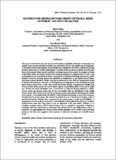| dc.contributor.author | Islam, lshrat | |
| dc.contributor.author | Zahur, Moushumi | |
| dc.date.accessioned | 2017-08-07T06:00:02Z | |
| dc.date.available | 2017-08-07T06:00:02Z | |
| dc.date.issued | 2016 | |
| dc.identifier.citation | Islam, lshrat, & Zahur, M. (2016). Housing for middle-income group of Dhaka: role of public and private sector. BRAC University Journal, XI(2), 17–25. | en_US |
| dc.identifier.issn | 18113079 | |
| dc.identifier.uri | http://hdl.handle.net/10361/8384 | |
| dc.description | This article was published in the BRAC University Journal [© 2016 Published by BRAC University]. | en_US |
| dc.description.abstract | Fast pace of urbanization and poor econoroy followed by inequitable distribution of resources bave
created severe housing problems in Dhaka city, particularly for low and middle income population.
With limited resource and capacity, the government bas contributed very little to address the housing
problem, particularly for middle income group. A number of site and service schemes were the major
focus of government which mostly beoefitted a privileged group of the society. In response to failure
of the public sector, the Formal Private Sector Housing emerged as a doroinant force to cater to the
housing demand of the resideoiB of Dhaka. Construction of apartment buildings bas becoroe a viable
solution to meet the growing demand for resideotial accommodation in the limited land of Dhaka.
Real estate business started in Dhaka in the late seventies and by the 1990s the business bad started
to flourish and expand at a fast pace. At the beginning, the target groop of the developers were the
upper income group of the society. But recently the private housing companies bave shifled their
focus to middle incoroe group who are the largest segment of population (about 50 percent) of Dhaka
city. Though real estate developers bave a coromitment to meet the housing demand of middleincome
people, the question arises how far the cost matches with the affordability of the middle
income group. This research reviewed the government policies and projects for housing the middle
incoroe groop. It also explored the affordability of the middle-incoroe group to meet the housing cost
developed by the private sector. The research bas stodied the cost of housing and existing modes of
payment for housing. Findings have compared with the targets groups' income and affordability. A
questionnsire survey bas been conducted on 180 middle-incoroe households located in four different
middle-income areas who bave plans to boy an apartment in the near futore. Officials of 20
developer companies (about 10% of total developers who are engaged in construction of aparbncnt
buildiogs) were also interviewed to understand their perspective on the middle-incoroe gmup. In
conclusion, the gap between the housing market and the aspiration of the middle incoroe bas been
portrayed. The study also suggested some measures to address the housing issue of middle income
gmup. | en_US |
| dc.format.extent | 9 pages | |
| dc.language.iso | en | en_US |
| dc.publisher | © 2016 Published by BRAC University | en_US |
| dc.subject | Dhaka | en_US |
| dc.subject | Housing | en_US |
| dc.subject | Middle-income group | en_US |
| dc.subject | Private developers | en_US |
| dc.subject | Poblic sector | en_US |
| dc.title | Housing for middle-income group of Dhaka: role of public and private sector | en_US |
| dc.type | Article | en_US |
| dc.description.version | Published | |

